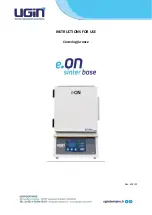
USSC
Page 9
FACTORY-BUILT OR METAL CHIMNEYS
If your home has an existing metal chimney, the same rules
apply as with masonry chimneys. One thing to be espe-
cially aware of is that "Class B" chimneys are for gas appli-
ances only, not solid fuel burners. If purchasing a new pack-
age, consult with the dealer. He will provide the necessary
parts and instructions for installation.
INSTALLING A NEW CHIMNEY
When installing a new chimney, whether it be masonry or
metal, if possible, it is recommended that it is placed within
the house structure. These chimneys remain warmer and,
in turn, radiate this warmth into the house. A chimney lo-
cated outside the house is exposed to cold temperatures
which encourages creosote build-up and poor chimney
draft.
CONNECTING STOVE PIPE TO A METAL
CHIMNEY
When using a metal chimney, part of the installation
package should include a stove pipe connector. Follow
the instructions provided with the chimney and its parts.
CHIMNEY DRAFT REGULATORS
(OPTIONAL) BAROMETRIC DAMPER
These devices are used to help maintain adequate chimney
draft automatically. They should be installed according to
their instructions and set at .04 to .06 inches of water column.
MANUAL DAMPER
(RECOMMENDED FOR ADDED SAFETY)
These are used to control chimney draft manually and
should be installed in a convenient place between furnace
and chimney. In the event of a chimney fire, it should be
closed reducing air to the chimney fire.
A combination of both barometric damper and manual
damper may be used. If this is the case, install the manual
damper between the barometric damper and the
chimney.
VENTILATION FOR YOUR FURNACE
There are many appliances which require "make up" air to
operate. However, with a combustion air draft fan, "make-
up" air is not usually necessary with your wood furnace.
If your home is sealed exceptionally well, use a 3" or 4"
diameter duct vented to the outside and terminating in the
vicinity of the combustion air draft fan. Also, it is possible for
your fans to draw in furnace smoke if there is only dead air
in the area. Note: It's highly recommended that a cold air
return system be utilized. Simply attach a 14" round to a
filter box adapter and attach to cold air return. Also, a
cold air return increases motor life.
CHIMNEY INSTALLATION
With the chimney being the most important part to
your installation, great care should be given to its
design.
MASONRY CHIMNEYS
If your intention is to use an existing masonry chim-
ney, check first with your local building official to see
if this is acceptable.
An older chimney, in need of repair, is the GREATEST
fire hazard in any installation.
STOVE PIPE (FLUE PIPE) CONNECTION
The flue pipe you should use is 6" or 8" 24 gauge or
heavier steel pipe.
When installing the flue pipe, make sure all joints are
secured with at least three (3) sheet metal screws. This
includes the connection to the flue collar of the fur-
nace. For added protection, use some high tempera-
ture furnace cement to seal each joint.
The stove pipe should slope upward to the chimney
at a rate of 1/2 inch per foot. Any horizontal runs of
stove pipe should not exceed six (6) feet and it should
be supported every four (4) feet. Note: Flue pipe
should be attached inside the flue pipe collar to pre-
vent creosote from running down onto electrical
motors.
CONNECTION OF FLUE PIPE TO A
MASONRY CHIMNEY
When connecting flue pipe to a masonry chimney,
there are two ways to go:
1.
The flue pipe itself can be cemented into the chim-
ney or;
2.
A thimble can be used which is cemented into the
chimney, and the flue pipe fits into the thimble.
In each case, care must be taken. The outer ma-
sonry (brick or block) must be chipped away, and
the inner liner must be pierced. The flue pipe or
thimble is then inserted flush to the inside face of the
tile liner. NOT ANY FURTHER!
Use furnace cement or mortar to seal this connec-
tion. When connecting the flue pipe, make sure the
attachment is secure enough so down draft or "puffs"
do not dislodge it.
FL
FL
FL
FL
FLUE RECOMMEND
UE RECOMMEND
UE RECOMMEND
UE RECOMMEND
UE RECOMMENDA
A
A
A
ATIONS
TIONS
TIONS
TIONS
TIONS


































